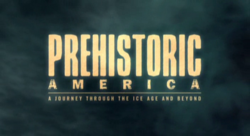Wild New World
| Wild New World | |
|---|---|

Series title card from US broadcast
|
|
| Also known as | 'Prehistoric America 野性新世界 (Chinese) |
| Genre | Nature documentary |
| Narrated by | Jack Fortune |
| Composer(s) | Barnaby Taylor |
| Country of origin | United Kingdom |
| Original language(s) | English |
| No. of episodes | 6 |
| Production | |
| Executive producer(s) | Neil Nightingale |
| Producer(s) | Miles Barton |
| Running time | 50 minutes |
| Production company(s) |
BBC Natural History Unit Discovery Channel |
| Release | |
| Original network | BBC Two |
| Picture format | 576i (16:9) |
| Audio format | Stereophonic |
| Original release | 3 October – 7 November 2002 |
| Chronology | |
| Preceded by | Wild Africa |
| Followed by | Wild Down Under |
| External links | |
| Website | |
Wild New World (also known as Prehistoric America) is a six-part BBC documentary series about Ice Age America - which discover the prehistory landscape and wildlife from the arrival of humans to the end of the Ice Age. It was first transmitted in the UK on BBC Two from 3 October to 7 November 2002. Like several other BBC programmes, it contains both computer graphics and real life animals. Occasionally, footage of non-American counterparts of the extinct North American beasts (like the American lion and the giant American cheetah) are used in juxtaposition with footage of native American animals, like the pronghorn.
Wild New World was co-produced by the BBC Natural History Unit and Discovery Channel. The music was composed by Barnaby Taylor and performed by the BBC Concert Orchestra. The series was narrated by Jack Fortune and produced by Miles Barton.
The series forms part of the Natural History Unit's Continents strand. It was preceded by Wild Africa in 2001 and followed by Wild Down Under in 2003.
The series was announced by the BBC with the working title All American Animals, but it was later changed to Wild New World.
All episode names were given from BBC website. All broadcast dates refer to the original UK transmission.
Each of the episode consists with the prehistory and wildlife of a particular region in the United States, except for final episode which is about various modern American animals.
Preserved in the frozen soil of Alaska are clues to an unknown land, where muskoxen and wild horses roarmed alongside woolly mammoths. Enormous American lions harried the families of mammoths, formidable in the defence of their young. The lion were more successful at hunting at bison in the snow but they were no match for the giant short-faced bear.
The first people to experience the splendours of the Grand Canyon would have seen a much greener, richer land. Today it is cougar country but then bizzare ground sloths sheltered in the caves and browsed in the canyons alongside Columbian mammoths. Camels were on the menu for both the first people and the impressive sabre-tooth cat (Smilodon).
America's Deep South is today a haven for the manatees, alligators and waterbirds which abound in its clear, turquoise springs. But when the Ice Age gripped much of the continent, the south was a warm paradise for the earliest human hunters as well as warmth loving wildlife. Tapirs and capybaras grazed in the swamps, dwarfed by the giant ground sloths which towered above them. Sabre-tooth cats came to face to face with skunks and jaguars stalked armoured glyptodons (Glyptotherium).
...
Wikipedia
